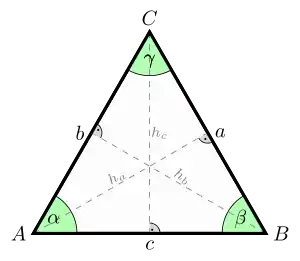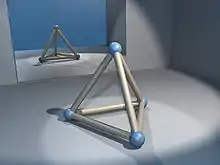Equilateral triangle
In geometry, an equilateral triangle is a triangle in which all three sides have the same length. In the familiar Euclidean geometry, an equilateral triangle is also equiangular; that is, all three internal angles are also congruent to each other and are each 60°. It is also a regular polygon, so it is also referred to as a regular triangle.
| Equilateral triangle | |
|---|---|
 | |
| Type | Regular polygon |
| Edges and vertices | 3 |
| Schläfli symbol | {3} |
| Coxeter diagram | |
| Symmetry group | D3 |
| Area | |
| Internal angle (degrees) | 60° |
Principal properties

Denoting the common length of the sides of the equilateral triangle as , we can determine using the Pythagorean theorem that:
- The area is ,
- The perimeter is
- The radius of the circumscribed circle is
- The radius of the inscribed circle is or
- The geometric center of the triangle is the center of the circumscribed and inscribed circles
- The altitude (height) from any side is
Denoting the radius of the circumscribed circle as R, we can determine using trigonometry that:
- The area of the triangle is
Many of these quantities have simple relationships to the altitude ("h") of each vertex from the opposite side:
- The area is
- The height of the center from each side, or apothem, is
- The radius of the circle circumscribing the three vertices is
- The radius of the inscribed circle is
In an equilateral triangle, the altitudes, the angle bisectors, the perpendicular bisectors, and the medians to each side coincide.
Characterizations
A triangle ABC that has the sides a, b, c, semiperimeter s, area T, exradii ra, rb, rc (tangent to a, b, c respectively), and where R and r are the radii of the circumcircle and incircle respectively, is equilateral if and only if any one of the statements in the following nine categories is true. Thus these are properties that are unique to equilateral triangles, and knowing that any one of them is true directly implies that we have an equilateral triangle.
Sides
Angles
Area
Equal cevians
Three kinds of cevians coincide, and are equal, for (and only for) equilateral triangles:[8]
- The three altitudes have equal lengths.
- The three medians have equal lengths.
- The three angle bisectors have equal lengths.
Coincident triangle centers
Every triangle center of an equilateral triangle coincides with its centroid, which implies that the equilateral triangle is the only triangle with no Euler line connecting some of the centers. For some pairs of triangle centers, the fact that they coincide is enough to ensure that the triangle is equilateral. In particular:
- A triangle is equilateral if any two of the circumcenter, incenter, centroid, or orthocenter coincide.[9]:p.37
- It is also equilateral if its circumcenter coincides with the Nagel point, or if its incenter coincides with its nine-point center.[7]
Six triangles formed by partitioning by the medians
For any triangle, the three medians partition the triangle into six smaller triangles.
Points in the plane
- A triangle is equilateral if and only if, for every point P in the plane, with distances p, q, and r to the triangle's sides and distances x, y, and z to its vertices,[11]:p.178,#235.4
Notable theorems

| 1. | Nearest distances from point P to sides of equilateral triangle ABC are shown. |
| 2. | Lines DE, FG, and HI parallel to AB, BC and CA, respectively, define smaller triangles PHE, PFI and PDG. |
| 3. | As these triangles are equilateral, their altitudes can be rotated to be vertical. |
| 4. | As PGCH is a parallelogram, triangle PHE can be slid up to show that the altitudes sum to that of triangle ABC. |
Morley's trisector theorem states that, in any triangle, the three points of intersection of the adjacent angle trisectors form an equilateral triangle.
Napoleon's theorem states that, if equilateral triangles are constructed on the sides of any triangle, either all outward, or all inward, the centers of those equilateral triangles themselves form an equilateral triangle.
A version of the isoperimetric inequality for triangles states that the triangle of greatest area among all those with a given perimeter is equilateral.[12]
Viviani's theorem states that, for any interior point P in an equilateral triangle with distances d, e, and f from the sides and altitude h,
independent of the location of P.[13]
Pompeiu's theorem states that, if P is an arbitrary point in the plane of an equilateral triangle ABC but not on its circumcircle, then there exists a triangle with sides of lengths PA, PB, and PC. That is, PA, PB, and PC satisfy the triangle inequality that the sum of any two of them is greater than the third. If P is on the circumcircle then the sum of the two smaller ones equals the longest and the triangle has degenerated into a line, this case is known as Van Schooten's theorem.
Other properties
By Euler's inequality, the equilateral triangle has the smallest ratio R/r of the circumradius to the inradius of any triangle: specifically, R/r = 2.[14]:p.198
The triangle of largest area of all those inscribed in a given circle is equilateral; and the triangle of smallest area of all those circumscribed around a given circle is equilateral.[15]
The ratio of the area of the incircle to the area of an equilateral triangle, , is larger than that of any non-equilateral triangle.[16]:Theorem 4.1
The ratio of the area to the square of the perimeter of an equilateral triangle, is larger than that for any other triangle.[12]
If a segment splits an equilateral triangle into two regions with equal perimeters and with areas A1 and A2, then[11]:p.151,#J26
If a triangle is placed in the complex plane with complex vertices z1, z2, and z3, then for either non-real cube root of 1 the triangle is equilateral if and only if[17]:Lemma 2
Given a point P in the interior of an equilateral triangle, the ratio of the sum of its distances from the vertices to the sum of its distances from the sides is greater than or equal to 2, equality holding when P is the centroid. In no other triangle is there a point for which this ratio is as small as 2.[18] This is the Erdős–Mordell inequality; a stronger variant of it is Barrow's inequality, which replaces the perpendicular distances to the sides with the distances from P to the points where the angle bisectors of ∠APB, ∠BPC, and ∠CPA cross the sides (A, B, and C being the vertices).
For any point P in the plane, with distances p, q, and t from the vertices A, B, and C respectively,[19]
For any point P in the plane, with distances p, q, and t from the vertices,[20]
and
where R is the circumscribed radius and L is the distance between point P and the centroid of the equilateral triangle.
For any point P on the inscribed circle of an equilateral triangle, with distances p, q, and t from the vertices,[21]
and
For any point P on the minor arc BC of the circumcircle, with distances p, q, and t from A, B, and C respectively,[13]
and
moreover, if point D on side BC divides PA into segments PD and DA with DA having length z and PD having length y, then [13]:172
which also equals if t ≠ q; and
which is the optic equation.
There are numerous triangle inequalities that hold with equality if and only if the triangle is equilateral.
An equilateral triangle is the most symmetrical triangle, having 3 lines of reflection and rotational symmetry of order 3 about its center. Its symmetry group is the dihedral group of order 6 D3.
Equilateral triangles are the only triangles whose Steiner inellipse is a circle (specifically, it is the incircle).
The integer-sided equilateral triangle is the only triangle with integer sides and three rational angles as measured in degrees.[22]
The equilateral triangle is the only acute triangle that is similar to its orthic triangle (with vertices at the feet of the altitudes) (the heptagonal triangle being the only obtuse one).[23]:p. 19

Equilateral triangles are found in many other geometric constructs. The intersection of circles whose centers are a radius width apart is a pair of equilateral arches, each of which can be inscribed with an equilateral triangle. They form faces of regular and uniform polyhedra. Three of the five Platonic solids are composed of equilateral triangles. In particular, the regular tetrahedron has four equilateral triangles for faces and can be considered the three-dimensional analogue of the shape. The plane can be tiled using equilateral triangles giving the triangular tiling.
Geometric construction

An equilateral triangle is easily constructed using a straightedge and compass, because 3 is a Fermat prime. Draw a straight line, and place the point of the compass on one end of the line, and swing an arc from that point to the other point of the line segment. Repeat with the other side of the line. Finally, connect the point where the two arcs intersect with each end of the line segment
An alternative method is to draw a circle with radius r, place the point of the compass on the circle and draw another circle with the same radius. The two circles will intersect in two points. An equilateral triangle can be constructed by taking the two centers of the circles and either of the points of intersection.
In both methods a by-product is the formation of vesica piscis.
The proof that the resulting figure is an equilateral triangle is the first proposition in Book I of Euclid's Elements.

Derivation of area formula
The area formula in terms of side length a can be derived directly using the Pythagorean theorem or using trigonometry.
Using the Pythagorean theorem
The area of a triangle is half of one side a times the height h from that side:
The legs of either right triangle formed by an altitude of the equilateral triangle are half of the base a, and the hypotenuse is the side a of the equilateral triangle. The height of an equilateral triangle can be found using the Pythagorean theorem
so that
Substituting h into the area formula (1/2)ah gives the area formula for the equilateral triangle:
Using trigonometry
Using trigonometry, the area of a triangle with any two sides a and b, and an angle C between them is
Each angle of an equilateral triangle is 60°, so
The sine of 60° is . Thus
since all sides of an equilateral triangle are equal.
In culture and society
Equilateral triangles have frequently appeared in man made constructions:
- The shape occurs in modern architecture such as the cross-section of the Gateway Arch.[24]
- Its applications in flags and heraldry includes the flag of Nicaragua[25] and the flag of the Philippines.[26]
- It is a shape of a variety of road signs, including the yield sign.[27]
References
- Bencze, Mihály; Wu, Hui-Hua; Wu, Shan-He (2008). "An equivalent form of fundamental triangle inequality and its applications" (PDF). Research Group in Mathematical Inequalities and Applications. 11 (1).
- Dospinescu, G.; Lascu, M.; Pohoata, C.; Letiva, M. (2008). "An elementary proof of Blundon's inequality" (PDF). Journal of inequalities in pure and applied mathematics. 9 (4).
- Blundon, W. J. (1963). "On Certain Polynomials Associated with the Triangle". Mathematics Magazine. 36 (4): 247–248. doi:10.2307/2687913.
- Alsina, Claudi; Nelsen, Roger B. (2009). When less is more. Visualizing basic inequalities. Mathematical Association of America. pp. 71, 155.
- Pohoata, Cosmin (2010). "A new proof of Euler's inradius - circumradius inequality" (PDF). Gazeta Matematica Seria B (3): 121–123.
- McLeman, Cam; Ismail, Andrei. "Weizenbock's inequality". PlanetMath. Archived from the original on 2012-02-18.
- Andreescu, Titu; Andrica, Dorian (2006). Complex Numbers from A to...Z. Birkhäuser. pp. 70, 113–115.
- Owen, Byer; Felix, Lazebnik; Deirdre, Smeltzer (2010). Methods for Euclidean Geometry. Mathematical Association of America. pp. 36, 39.
- Yiu, Paul (1998). "Notes on Euclidean Geometry" (PDF).
- Cerin, Zvonko (2004). "The vertex-midpoint-centroid triangles" (PDF). Forum Geometricorum. 4: 97–109.
- "Inequalities proposed in "Crux Mathematicorum"" (PDF).
- Chakerian, G. D. "A Distorted View of Geometry." Ch. 7 in Mathematical Plums (R. Honsberger, editor). Washington, DC: Mathematical Association of America, 1979: 147.
- Posamentier, Alfred S.; Salkind, Charles T. (1996). Challenging Problems in Geometry. Dover Publ.
- Svrtan, Dragutin; Veljan, Darko (2012). "Non-Euclidean versions of some classical triangle inequalities" (PDF). Forum Geometricorum. 12: 197–209.
- Dörrie, Heinrich (1965). 100 Great Problems of Elementary Mathematics. Dover Publ. pp. 379–380.
- Minda, D.; Phelps, S. (2008). "Triangles, ellipses, and cubic polynomials". American Mathematical Monthly. 115 (October): 679–689. doi:10.1080/00029890.2008.11920581. JSTOR 27642581.
- Dao, Thanh Oai (2015). "Equilateral triangles and Kiepert perspectors in complex numbers" (PDF). Forum Geometricorum. 15: 105–114.
- Lee, Hojoo (2001). "Another proof of the Erdős–Mordell Theorem" (PDF). Forum Geometricorum. 1: 7–8.
- Gardner, Martin, "Elegant Triangles", in the book Mathematical Circus, 1979, p. 65.
- Meskhishvili, Mamuka (2021). "Cyclic Averages of Regular Polygonal Distances" (PDF). International Journal of Geometry. 10: 58–65.
- De, Prithwijit (2008). "Curious properties of the circumcircle and incircle of an equilateral triangle" (PDF). Mathematical Spectrum. 41 (1): 32–35.
- Conway, J. H., and Guy, R. K., "The only rational triangle", in The Book of Numbers, 1996, Springer-Verlag, pp. 201 and 228–239.
- Leon Bankoff and Jack Garfunkel, "The heptagonal triangle", Mathematics Magazine 46 (1), January 1973, 7–19.
- Pelkonen, Eeva-Liisa; Albrecht, Donald, eds. (2006). Eero Saarinen: Shaping the Future. Yale University Press. pp. 160, 224, 226. ISBN 978-0972488129.
- White, Steven F.; Calderón, Esthela (2008). Culture and Customs of Nicaragua. Greenwood Press. p. 3. ISBN 978-0313339943.
- Guillermo, Artemio R. (2012). Historical Dictionary of the Philippines. Scarecrow Press. p. 161. ISBN 978-0810872462.
- Riley, Michael W.; Cochran, David J.; Ballard, John L. (December 1982). "An Investigation of Preferred Shapes for Warning Labels". Human Factors: The Journal of the Human Factors and Ergonomics Society. 24 (6): 737–742. doi:10.1177/001872088202400610.

